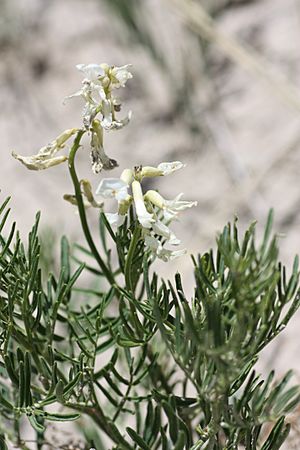Osterhout milkvetch facts for kids
Quick facts for kids Osterhout milkvetch |
|
|---|---|
 |
|
| Conservation status | |
| Scientific classification |
The Osterhout milkvetch (scientific name: Astragalus osterhoutii) is a very rare plant. It's a type of wild pea plant, and you can only find it in one special place: Grand County, Colorado. Specifically, it grows in a mountain area called Middle Park. Because it's so rare, the United States government has listed it as an endangered species. This means it's in danger of disappearing forever!
Contents
What is the Osterhout Milkvetch?
This plant is a perennial herb. This means it lives for many years, not just one. It grows tall, with many thin, green stems that can reach up to a meter (about 3 feet) high. Its leaves are interesting, made of several small, narrow leaflets. Each leaflet can be up to 3 centimeters long.
Flowers and Fruits
The Osterhout milkvetch produces beautiful, cream-colored flowers. These flowers look a lot like small pea flowers. Each one is over 2 centimeters long. After the flowers bloom, the plant grows a fruit. This fruit is a flat legume pod. It can grow up to 4 centimeters long.
Where Does it Live?
This special plant grows in badlands areas. These are dry, eroded lands often found in sagebrush habitats. The soil where it grows is very unique. It comes from rock formations called the Niobrara Formation and the Pierre Shale. This soil is a gray-brown clay, made of shale and siltstone.
A Unique Soil Trait
The soil where the Osterhout milkvetch lives has a lot of a natural element called selenium. The plant actually takes in this selenium from the soil. Because of this, the plant can develop a strange, foul odor!
Why is it Endangered?
The Osterhout milkvetch faces several threats that make it an endangered species. One big problem is flooding. Also, new reservoirs being built have destroyed at least one place where the plant used to grow.
Human Activities
Other human activities also harm the plant's home. Using All-terrain vehicles (ATVs) can damage the delicate soil and plants. Also, activities like oil and gas exploration can disturb the habitat. These actions make it harder for the Osterhout milkvetch to survive and thrive.
How it Got its Name
The Osterhout milkvetch was named after a botanist. A botanist is a scientist who studies plants. His name was George Everett Osterhout.


